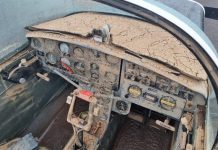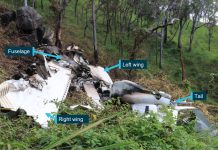By Roger Alder
The sudden energy release from the ‘big bang’ of an exploding outer combustion chamber of a Rolls-Royce (Allison) 250 engine is minuscule relative to the cosmic expansion of the universe. But what was happening before the big bang? And while cosmologists ponder the age of the universe, helicopter operators have a more urgent question: when will the next big bang happen?
As the silky whine of the turbine engine edged higher for take-off, so did the eager anticipation among members of a family in the cabin of a Bell 407 poised on the helideck of a private luxury cruiser anchored in Talbot Bay, Australia. Seconds after lift-off, an explosion from the engine abruptly changed passenger mood from excitement to screaming terror, as their seat belts first held them during slow motion seconds of near weightlessness as the helicopter dropped over the side of the cruiser; and then against violent deceleration forces as the helicopter plunged into the sea and rolled inverted, the cabin immediately filling with water.
Underwater escape from an inverted helicopter is something that requires special training, which these holidaymakers did not have. Although it was a very close call for one family member who was temporarily trapped in the cabin, everyone survived.
The Australian Transport Safety Bureau (ATSB), found that ‘the engine’s outer combustion chamber (OCC), the main pressure vessel of the Rolls-Royce (Allison) 250 C47 engine, had exploded,’ rupturing like a tin can carelessly thrown into a camp fire as a stupid prank.
The Allison Model 250 turboshaft (or Rolls-Royce M250, since the British company’s takeover of Allison in 1995) is a compact, powerful and light (62 kg) engine that has powered a wide variety of helicopters and fixed-wing aircraft since the 1960s.
Its designation refers to its shaft horsepower output, more than doubled to 615 shp in the latest versions. Rolls-Royce says 16,000 of the 31,000 made are in service and the design has logged 220 million hours.
The M250’s outer combustion chamber is a thin sheet metal duct stamped and welded into a shape resembling that squat-headed, barrel-chested robot—readers of a certain age might usefully recall—R2-D2 from Star Wars.
When the combustion chamber explodes, the primary high-pressure flame that drives the turbines dies instantly. It’s the same as the head completely blowing off a piston engine.
The OCC was found to have suffered extensive cracking along the welded seams under both of its ‘armpits’. An ‘armpit’ crack on one side of the OCC had weakened the pressure vessel to the point where it had suddenly exploded, resulting in the immediate and total power loss which had dropped the helicopter and its occupants into the sea.
On 27 September 2016, CASA issued AWB 72-003 to urge all Rolls-Royce Allison 250 operators to immediately undertake detailed inspections of the OCC, particularly along the ‘armpit’ welded seams and strengthening patches, using techniques including a 10X magnifying glass and a bright light.
Although the problem of OCC ‘armpit’ cracking and rupture had existed for many years, and the manufacturer had developed special inspections and ‘armpit’ repair patches to strengthen the critical area, (FAA AD 85/25/07 R1/AD/AL 250/59 Amdt 3) this explosive rupture posed a new threat. Undetected cracks had allowed combustion pressure to rip through the ‘armpit’ patches. Using the inspection procedures recommended in AWB 72-003 Issue 1, maintenance engineers using a 10X magnifying lens reported finding previously undetected cracking in the OCC armpit welded area.
Around the time of the Talbot Bay failure, there was a similar incident in Papua New Guinea, where one of the OCC strengthening ‘armpit’ patches had ruptured during take-off, this time dumping the helicopter and its occupants on to the sloping bank of a river and rolling over. Fortunately, all survived, although some passengers were injured.
Following publication of AWB 72–003, no more OCC ruptures were reported in Australia; however, in 2012, another Rolls Royce (Allison) 250 OCC ruptured on one engine in a Sikorsky S76 during final descent over salt water at Langara Island, British Columbia. Following a successful ditching, one float deflated and the helicopter gently rolled inverted in the water after the pilot and the passenger had stepped on to a waiting boat. The Transport Canada Transport Safety Board (TSB) Investigation found (Report A12P0134), as had the ATSB years before (Report AO-2008-067), that the rupture started with undetected cracks in the ‘armpit’ region that had been growing for some time. The TSB found the cracks had not been detected because the manufacturer’s inspection requirements were inadequate.
The OCC is currently remains an ‘on-condition’ item, meaning ‘keep inspecting until a defect is found’. But why depend on inspection frequency and technique to allow such a critical item to remain in service, instead of retiring it at the end of a known safe fatigue life?
The inconvenient truth is, that while failures seem to be related to pressure cycles associated with starts, no one really knows what the OCC fatigue life is.
Predicting useful life by tracking starts is pretty much a lost cause. To begin with, who’s counting? As well, although failures may be related to start cycles, the evidence suggests that OCC failures are occurring during take-off and landing. For any one start, where the OCC is subjected to a brief, deep-throated, teeth-rattling vibration phase and a dramatic rise in pressure as the engine stabilises at idle RPM, there could be quite a few more torque-related pressure cycles per flight hour. Pressure-cycle counting should probably be more like the Bell Helicopter Textron main rotor mast retirement index number (RIN) tracking. But there is no requirement to track OCC start cycles or flight hours, let alone torque events.
There are other factors. Faulty repairs. And one would have to completely ignore the rules of physics to say that the thin stainless steel sheet metal combustion chamber, being continually exposed to any fine particulate in the compressor airflow and the heat of combustion would not get thinner over time—another fatigue factor identified in the TSB report.
It has also been suggested that the ‘cracks’ in the OCC which follow along the edge of weld lines as sharply as if cut by a razor, display the classic characteristics of ‘knife-line attack’ (KLA), which is an intergranular corrosion attributed to improper heat treatment following welding.
One anecdotal comment made to CASA on this issue was that a pilot could tell when the OCC was cracking between inspections, because there would be a loss of torque and increasing turbine outlet temperature (TOT) in flight, due to gas leaks from the OCC. Although CASA AWB 72-003 Issue 2 does identify one very close-call case, no one can predict how long you have between initial cracking and total OCC failure.
Further, the ATSB report quotes the engine manufacturer as saying the cracking shown in AWB 27-003 Issue 2 Figures 2&3, would not be noticeable on the engine instruments. The Canadian TSB report also states that the operator of the Sikorsky S76 which suffered the in-flight OCC rupture, found another six Rolls-Royce (Allison) 250 powered helicopters in the fleet, all of which had been flying with undetected cracks in their OCCs. Oh yes, and a few flight hours later, an additional unscheduled OCC inspection found one more. So, the in-flight method is not that reliable, if at all.
Although some operators are now counting cycles and flight hours to try and establish a useful life, there are so many Rolls Royce (Allison) 250 series OCCs out in the world with unknown flight hours and pressure cycles that establishing and imposing a retirement life on the OCC today appears virtually impossible.
It all comes down to this: safe operation of the OCC remains totally reliant on frequent and vigilant inspections.
Although the manufacturer has devised improved repairs and shortened the flight hours between inspections, it seems that inspections which focus around the ‘armpit’ zone welds, and which include using a 10X glass and bright light at least every 100 flight hours—more frequently for those OCCs exposed to marine conditions and suspected ‘tired’ OCCs—remains a highly effective method in avoiding the next ‘Big Bang’.








